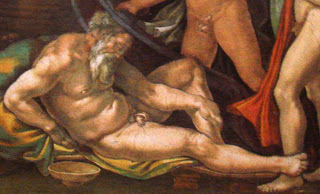Saturday, October 17th, 2009
Sistine Chapel: Noah and Adam
In order to understand the significance, though, I should explain more about the program of the Sistine Chapel. The panels on the ceiling depict early moments in biblical history, which mainly focus on events around/during the Creation, Fall, and Flood. What is interesting, though, is that one who enters the chapel sees the panels in an anachronistic manner. In other words, the last panel, The Drunkenness of Noah, is the one that is placed over the entrance to the chapel (The Drunkenness of Noah is at the top of this image of the ceiling). As one walks further and further into the chapel, the biblical scenes go backwards in time, showing the Flood, then the Expulsion from the Garden, then the Creation of Adam. Scenes of the Creation appear at the other end of the chapel, culminating in God’s Separation of Light from Darkness (which is located over the altar).
Radke pointed out that it this reversed order is intentional. As one moves closer to the altar and celebration of the mass, one moves closer to God and closer to the moment of purity in the Creation. I think that’s beautiful symbolism; it is as if one moves closer to purity as he/she walks further away from the chapel doorway and the sin that exists in the world. That point is even further emphasized by the choir screen that bisects the length of the Sistine Chapel. The Creation of Adam is placed directly above the choir screen. Therefore, the visitor arrives at that depiction of purity and innocence as he or she walks through the choir screen partition.*
With all this in mind, it’s interesting to see a similarity between Adam and Noah. Noah is shown as a fallen, sinful, elderly man. In contrast, Adam represents the innocence, purity, and youth of the Creation. Yet the two figures are shown in the same position, which emphasizes that Adam and Noah also serve as broader symbols of humanity. I really like that.
*Granted, not everyone would have been able to walk through the choir screen. The lay people would have been expected to stay on the side of the screen which is closest to the doorway. (Too bad for them, huh? They would never be able to approach the pure, sinless moments depicted in the Creation scenes.) Nonetheless, one can still see how the choir screen fits into the program and symbolism of the ceiling.


But when you visit the Sistine Chapel today, you walk from the altar back towards the screen, don't you?
The Sistine Chapel is okay. LOL I don't know if I had super-high expectations or what, but when I saw it in person, I was kind of underwhelmed. I did really like The Last Judgment, though.
Yeah, you're completely right. Radke pointed out how today the symbolism and program of the ceiling does not have the same effect, since visitors enter the chapel by the altar.
My visit to the Sistine Chapel wasn't that amazing either, I'll admit it. It was mostly because the speakers kept blaring the announcement to "keep quiet" in a bigillion different languages. I don't know how anyone can have a great experience with art when a voice is shouting at them to be reverent and respectful.
I liked the Last Judgment, too. I just went to an exhibition that showed 16th c. engravings (by Giorgio Ghisi) of the Last Judgment The engravings were made shortly before the fresco was censored and slightly modified after Michelangelo's death. It was pretty interesting to see these engravings and compare them to the changes that now exist. If I can find images, I'll do a post on it later.
It is hard for me to forget how annoyed I was by the loud whispers, the occasional errant flash, and the "announcements" in the chapel.
I thought for certain I had left a comment on this post! I guess not! Well, I think it is very interesting that Adam and Noah are positioned similarly. I wonder, like you, if it has deeper meaning or symbolism. I also wonder if it could just be that Michelangelo liked those kind of angles better. Is that weird? I think about how I have my “good” side and that’s the side I like my picture taken from. Ha ha, pretty ridiculous.
I also wanted to say I found it really interesting that you and your readers commented on the Sistine chapel not being quite up to expectations. That’s so interesting to me. I’ve never been there, but it makes me think of Arlington National Cemetery and how at the changing of the guard, they yell at you to stand up and BE QUIET. I’ve also heard the guards yell a couple times by JFK/the eternal flame. Part of me loves that they INSIST upon respect, but the other part thinks that they’ve replaced the noise and shuffle of people with an announcement that takes away from the respectful atmosphere just as much as the other.